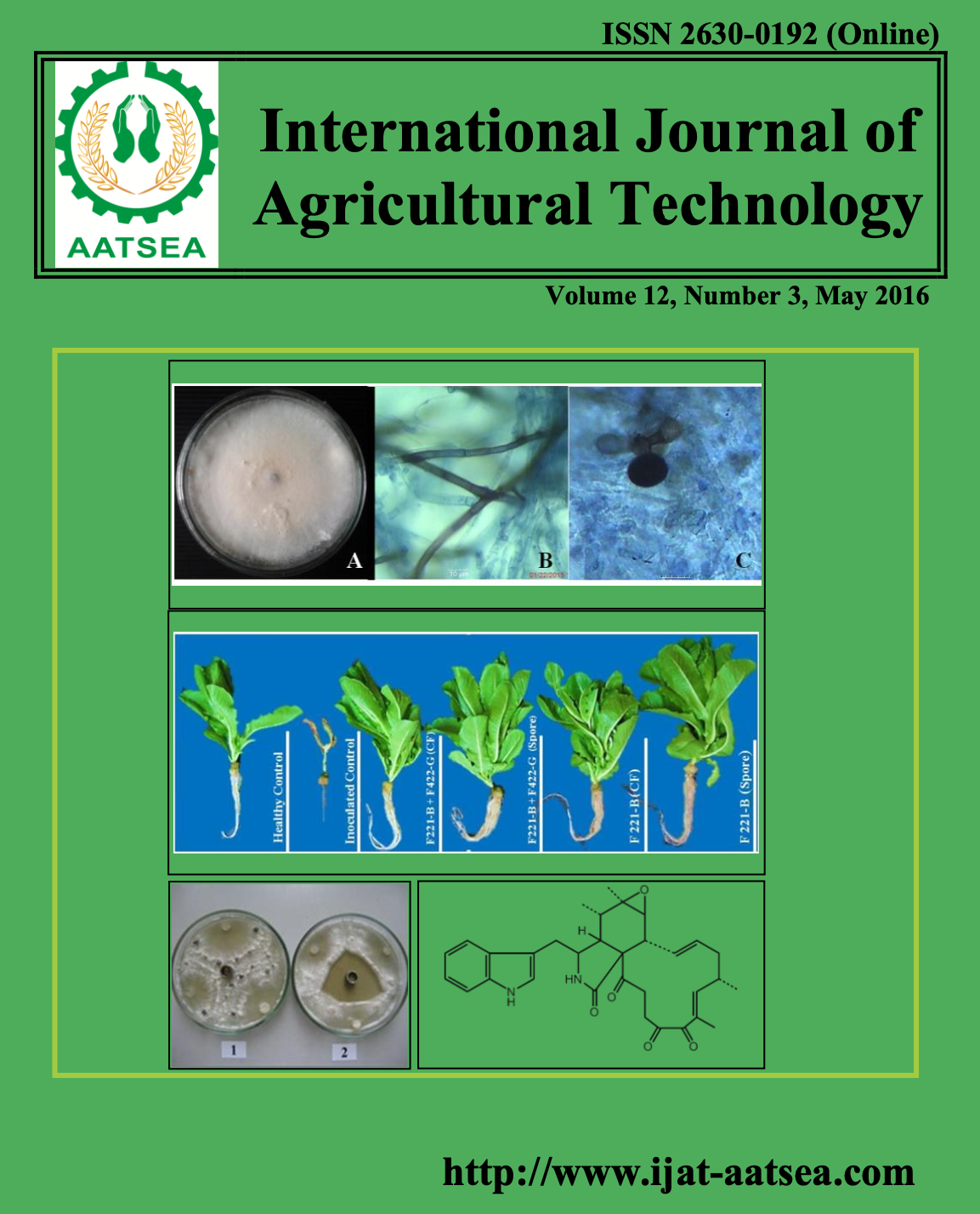Antifungal activity of endophytic fungi from palm trees against coffee anthracnose caused by Colletotrichum coffeanum
Main Article Content
Abstract
Endophytic fungi are able to produce mixture of volatile organic compounds that are lethal to human and plant pathogenic fungi and bacteria. Endophytic fungi Nigrospora sphaerica isolated from Chrysalidocarpus lotescens and Fusarium falciforme isolated from Mascarena Lagencuuliswere identified by morphological characters and molecular phylogeny on the basis of ITS1-5.8S-ITS4 ribosomal gene sequence acquisition and analyses. Crude hexane, ethyl acetate and methanol of these two endophytic fungi were yielded and examined for bioactivity test against Colletotrichum coffeanum causing coffee anthracnose. The results showed that crude methanol from Nigrospora sphaerica and Fusarium falciforme gave the highest inhibition of colony growth of C. coffeanum, which were 54.00% and 63.00%, respectively at concertration of 1000, 500 ppm, respectively. Methanol crude extract from Fusarium falciforme showed significantly highest inhibition for the spore production of C. coffeanum as 76.74% at the concentration of 500 ppm with effective dose (ED50) for spore production inhibition at concentration 161.14 ppm. The research findings are reported that the metabolites from Nigrospora sphaerica and Fusarium falciforme acts as new antagonist against C. coffeanum causing coffee anthracnose.
Article Details

This work is licensed under a Creative Commons Attribution-NonCommercial-NoDerivatives 4.0 International License.
References
Altschul, S. F., Madden, T. L., Schaffer, A. A., Zhang, J. H., Zhang, Z., Miller, W. and Lipman, D. J. (1997). Gapped BLAST and PSI-BLAST: a new generation of protein database search programs. Nucleic Acids Research 25:3389-3402.
Bacon, C. W. and White, J. F. (2000). Microbial Endophytes. New York: Marcel Deker Inc.
Carroll, G. C. (1988). Fungal endophytes in stems and leaves: from latent pathogen to mutualistic symbiont. Ecology 69:2-9.
Charoenporn, C., Kanokmedhakul, S., Lin, F. C., Poeaim, S. and Soytong, K. (2010). Evaluation of bio-agent formulation to control Fusarium wilt of tomato. African Journal of Biotechnology.
Ellis, M. B. (1971). Dematiaceous Hyphomycetes. Commonwealth Mycological Institute. Kew. pp. 312-318.
González, G. V. (2000). Biotechnology and the future of coffee production. In Sera, T., Soccol, C. R., Pandey, A. and Roussos, S. (Eds), Coffee: biotechnology and quality. Dordrecht, Boston, London: Kluwer Academic Publishers. pp. 1-16.
Kanokmedhakul, S., Kanokmedhakul, K., Prajuabsuk, T., Soytong, K., Kongsaeree, P. and Suksamran, A. (2003). A bioactive triterpenoid and vulpinic acid derivatives from Scleroderma citrinum. Planta Medica 69:566-568.
Lee, J. C., Lobkovsky, E., Pliam, N. B., Stroble, G. A. and Clardy, J. (1995). Subglutinol A and B: immunosuppressive compounds from the endophytic fungus Fusarium subglutinans. The Journal of Organic Chemistry 60:7076-7077.
Luiz, H. R., Nurhayat, T., Natascha, T., Wedge, D. E., Zhiqiang, P., Bernier, U. R., Becne, J. J., Agramonte, N. M., Walker, L. A. and Moraes, R. M. (2012). Diversity and biological activities of Endophytic fungi associated with Micropropagated medicinal plant Echinacea purpurea (L.) Moench. American Journal of Plant Sciences 3:1105-1114.
Masroor, Q., Johri, S., Shah, B. A., Khajuria, A., Sidiq, T., Lattoo, S. K., Abdin, M. Z. and Riyaz-Ul-Hassan, S. (2013). Identification and bioactive potential of endophytic fungi isolated from selected plants of the Western Himalayas. SpringerPlus 2:8
Meca, G., Soriano, J. M., Gaspari, A., Ritieni, A., Moretti, A. and Mañes, J. (2010). Antifungal effects of the bioactive compounds enniatins A, A(1), B, B(1). Toxicon 56:480-485
Pakdeevaraporn, P., Wasee, S., Taylor, P. W. J. and Mongkolporn, O. (2005). Inheritance of resistance to anthracnose caused by Colletotrichum capsici in Capsicum. Plant Breeding 124:206-208.
Sibounnavong, P., Soytong, K., Divina, C.C. and Sofrio, P.K. (2009). In-vitro biological activities of Emericella nidulans, a new fungal antagonist against Fusarium oxysporum f. sp. lycopersici. Journal of Agricultural Technology 5:75-84.
Song, J. J., Pongnak, W. and Soytong, K. (2015a). Biological activity of endophytic fungi associated with palm trees. Journal of Agricultural Technology 11:567-579.
Song, J. J., Pongnak, W. and Soytong, K. (2015b). Biological activity of endophytic fungi from palm trees against chili anthracnose caused by Colletotrichum capsici. Journal of Agricultural Technology 11:1819-1832.
Soytong, K. (1992). Biological control of rice blast disease by seed coating with antagonistic fungi. Songklanakarin Journal of Science and Technology 14:59-65.
Soytong, M. and Poeaim, S. (2014). Isolation and identification of Trichocomaceae from soil by morphology and DNA sequencing. Proceedings of the 3rd International Conference on Integration of Science and Technology for Sustainable Development, Pakse, Laos, 27-28 November 2014. pp. 51-62.
Stierle, A., Strobel, G. A. and Stierle, D. (1993). Taxol and taxane production by Taxomyces andreanae, an endophytic fungi of Pacific yew. Science 260:214-216.
Strobel, G. A. and Daisy, B. (2003). Bioprospecting for microbial endophytes and their natural products. Microbiology and Molecular Biology Reviews 67:491-502.
Stroble, G. A. and Hess, W. M. (1997). Glucosylation of the peptide leucinostatin A, produced by an endophytic fungus of European yew, may protect the host from leucinostatin toxicity. Chemistry and Biology 4:529-536.
Tamura, K., Dudley, J., Nei, M. and Kumar, S. (2007). MEGA4: Molecular evolutionary genetics analysis (MEGA) software version 4.0. Molecular Biology and Evolution 24:1596-1599.
Walker, K. and Croteau, R. (2001). Taxol biosynthetic genes. Phytochemistry 58:1-7.
Wang, J., Li, G., Lu, H. Zheng, Z., Huang, Y. and Su, W. (2000). Taxol from Tubercularia sp. strain TF5, an endophytic fungus of Taxus mairei. FEMS Microbiology Letters 193:249-253.
Wiyakrutta, S., Sriubolmas, N., Panphut, W., Thongon, N., Danwisetkanjana, K., Ruangrungsi, N. and Meevootisom, V. (2004). Endophytic fungi with anti-microbial, anti-cancer and anti-malarial activities isolated from Thai medicinal plants. World Journal of Microbiology and Biotechnology 20:272-278.
Woropong, J., Strobel, G. A., Ford, E. J., Li, J. Y., Baird, G. and Hess, W. M. (2001). Muscodor albus anam. nov., an endophyte from Cinnamomum zeylanicum. Mycotaxon 79:67-79.
Zhao, J. H., Zhang, Y. L., Wang, L. W., Wang, J. Y. and Zhang, C. L. (2012). Bioactive secondary metabolites from Nigrospora sp. LLGLM003, an endophytic fungus of the medicinal plant Moringa oleifera Lam. World Journal of Microbiology and Biotechnology 28:2107-2112.


